Until recently, the Temple of the Feathered-Serpent at Teotihuacan was known as the Pyramid of Quetzalcoatl, and it is also referred to as the Temple of the Plumed-Serpent due to its Spanish name, Templo de la Serpiente Emplumada. This temple derives its name from the iconic carved heads that adorn its eastern side (figs. W2-0037 & W2-0035). These intricately crafted heads were added during the temple’s initial construction in the 3rd century. The high-relief images alternate between a serpent’s head surrounded by feathers and a crocodile’s head adorned with a headdress. The former is easily recognized as the Aztec creator god Quetzalcoatl (which translates to “Feathered Serpent” in Nahuatl).
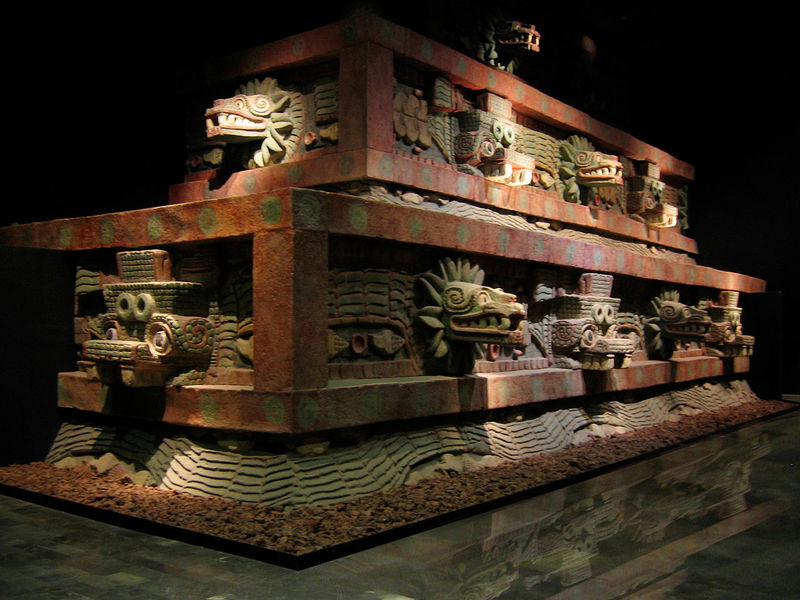
The latter is believed to represent either the crocodile deity Cipactli or the Fire-Serpent, due to its goggle-eyes. Between these heads is a bas-relief of a snake’s body, featuring the skeletal rattle of a rattlesnake. On the talud section (the small sloping wall beneath the vertical tablero section), there are full-length bas-relief images of an undulating serpent.
Teotihuacano Art and Symbolism
Teotihuacano art was designed to convey ideas and record events, effectively serving as their written language. It uses combinations of elements, known as pictographs and ideograms, to resemble objects, portray people, denote places, recount traditions, describe religious concepts, and record historical or celestial events. On the Temple of the Feathered Serpent, we see a number of elements likely designed to recount a story, a religious concept, and a historical event all at once, which was very common.
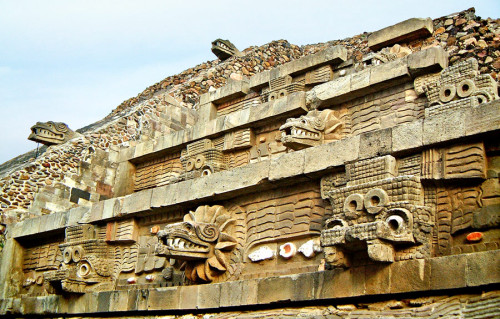
Iconography of Quetzalcoatl and Other Deities
The most identifiable elements are within the carved representations of Quetzalcoatl (fig. W2-0035C). Here, the feathers surrounding the serpent’s head indicate that this is the feathered-serpent; the feathers represent the petals of flowering crops, signifying that he brings the harvest. Additionally, the feathers symbolize rays of light, associating him with the Sun. Meanwhile, the curling eyebrow represents duality (a double spiral), infinity, and the swirling cosmos.
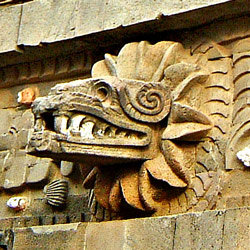
Unfortunately, the crocodile element is not as well understood and is still debated among scholars. Aztec legend speaks of a crocodilian god, named Cipactli, who ate the gods’ failed attempts at creating man at the end of each aborted epoch known as a Sun. Following the creation of the Fifth Sun, Quetzalcoatl and Tezcatlipoca ensnared her and ripped her in two to create the land on which humans could live, with the hilly terrain resembling the scaly back of a crocodile.
The Crocodilian Element
The crocodilian element wears a headdress that features a talud-tablero temple and two circles (possibly obsidian mirrors, the eyes of Tlaloc, or warrior goggles), representing Teotihuacan. This suggests that the Fifth Sun was created by Quetzalcoatl at Teotihuacan. Other sources propose that the crocodilian element, with its protruding snout, might refer to the Fire Serpent known as Xiuhcoatl.
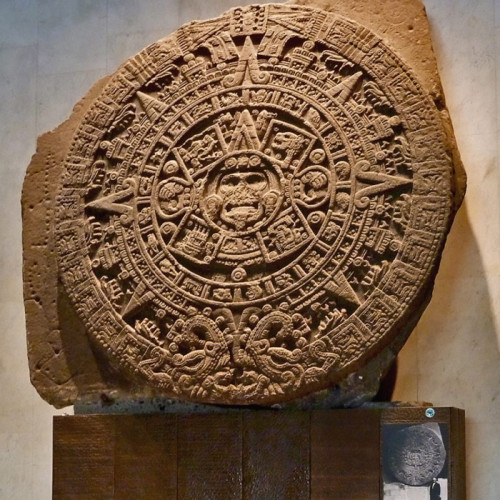
He guided the sun across the sky and represented the ecliptic plane. The snout on the Temple of the Feathered Serpent appears to curl up in profile, similar to the depiction of Xiuhcoatl on the Aztec Calendar Stone, where the rattle element is also found near Xiuhcoatl’s tail. Therefore, the projecting carved heads on the tablero section of the Temple of the Feathered Serpent likely alternate between the Feathered Serpent, with a normal snake tail, and the Fire Serpent, with its rattlesnake tail.
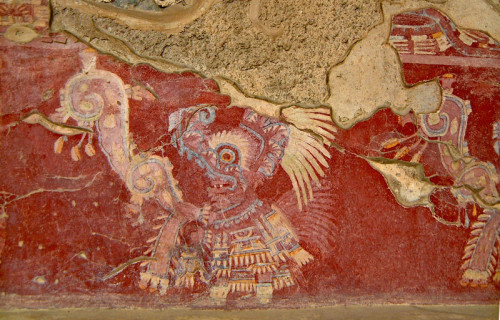
Symbolism in Headdresses
Identical symbolism is found in the headdresses worn by the priests of the Teotihuacan precinct of Tepantitla. The priests are depicted sowing seeds or giving offerings to the earth (fig. W2-0024). Their headdresses combine an elongated curling snout with the eye of an owl and the feathers of the quetzal. The curling snout matches that found on the Aztec Calendar Stone, which is remarkable considering the mural of Tepantitla was created before 400 AD and the calendar stone was produced in 1479 AD.
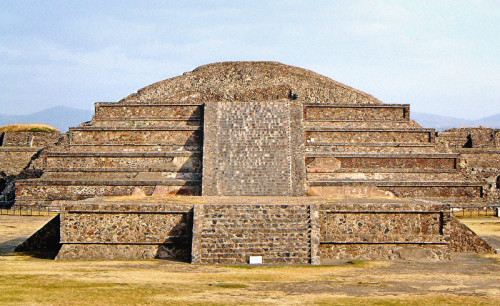
At Tepantitla, the element is clearly crocodilian, and looking again at the Aztec Calendar Stone, there is a crocodilian arm located just behind each of Xiuhcoatl’s heads. The imagery on the Calendar Stone reflects the legend of Cipactli being ripped in two, suggesting that the Fire-Serpent and Cipactli might be two aspects of the same being. Both characters appear to represent fundamental elements of the ritual calendar and possibly the creation of time and the cosmos.
The Tunnel Beneath the Pyramid
A tunnel beneath the Pyramid of Quetzalcoatl contains strong references to the cosmos, with hundreds of clay spheres covered in golden pyrite and metallic dust on the walls, resembling a passageway through space when illuminated by torchlight. Archaeologists, with the help of a small robot named Tlaloc II, are still making discoveries. So far, there is no evidence that the tunnel or the three caves at its end were used for elite burials. Instead, the tunnel and cave network appears to have been a shrine to the cosmos and the gods of creation. Caves were thought to be the place where gods were born, and it is possible that the Teotihuacan elite used the caves beneath the Temple of Quetzalcoatl for childbirth, symbolizing a cosmic womb or a descent from the heavens.
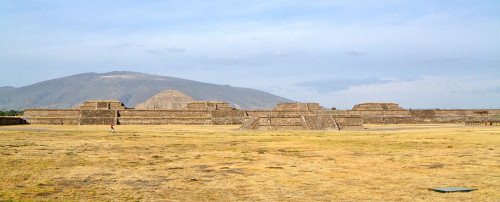
In Mayan mythology, the crocodile was associated with the Great Rift, a dark patch within the Milky Way, considered the womb of the galaxy, from which planets, stars, the cosmos, and time were born. It is likely that the crocodilian form on the Temple of the Feathered Serpent was also associated with this facet of the night sky, representing the birth of the cosmos and the beginning of time. The Temple of the Feathered Serpent, with its four stepped talud-tablero levels, may have been designed to commemorate the four preceding suns, with a temple on top dedicated to the Fifth Sun.
Preservation and Structure
The western face of the Pyramid of Quetzalcoatl has been well preserved because it was buried beneath the “Adosado” platform added to the front (fig. W2-0032). Some suggest this was a deliberate attempt to cover the pyramid’s iconic façade and alter its purpose. However, all three of Teotihuacan’s great pyramids had such features added for unknown reasons, and the three other faces of the Temple of the Feathered Serpent were left exposed. Based on the exposed face, it is estimated that the combined four faces would have totaled 260 Feathered-Serpent heads, equaling one for each day of the ritual calendar. It is thought that the small gap between the teeth at the front would have been used to leave offerings or place a day marker, indicating the current day to the population. Burials found within the temple’s foundations suggest a strong link with the ritual calendar. So far, more than 200 sacrificial victims have been found, with their hands bound behind their backs and their bodies strategically placed. Archaeologists believe that once excavation is complete, this body count will equal 260, representing one day of the Sacred Calendar.
The Ciudadela Complex
Around the perimeter of the Ciudadela complex, in which the Temple of the Feathered Serpent sits, there are 11 smaller pyramidal structures on a raised base, with four on each side and three at the rear (four of these are visible in fig. W2-0024). Adding the Adosado platform and the Temple of the Feathered Serpent, there are 13 structures in total, representing each day of a Trecena. This evidence demonstrates that the Pyramid of the Feathered Serpent was dedicated to the Ritual Calendar and its festivities. The Ciudadela enclosure is the largest defined space at Teotihuacan, measuring a massive 130 m². It could accommodate the entire population, which exceeded 100,000 people. Two large complexes of rooms on either side of the Temple of the Feathered Serpent would have provided ideal preparation areas for the festivities and accommodation for the priests who kept track of the days. At the heart of this complex lies the Temple of the Feathered Serpent, designed to record the creation of the cosmos and the passing of time from that day onward. Essentially, the Temple of the Feathered Serpent is a monument to time and the heart of a giant clock by which the Teotihuacano honored their gods.




